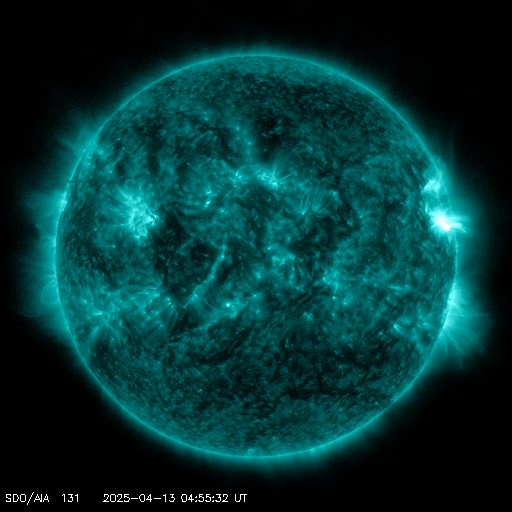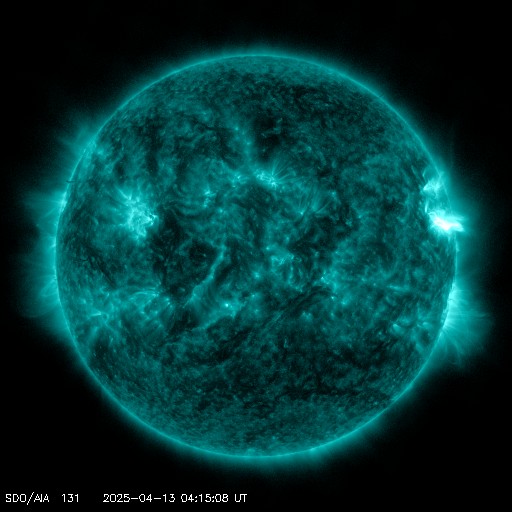Het archief bekijken van zondag 17 november 2024
Dagelijks bulletin over zonne- en geomagnetische activiteit van het SIDC
Datum verslag: 2024 Nov 17 1257 UTC
SIDC Prognose
Zonnevlammen
C-class flares expected, (probability >=50%)
Geomagnetisme
Quiet (A<20 and K<4)
Proton Flux monitor
Quiet
| 10cm flux | Ap | |
|---|---|---|
| 17 Nov 2024 | 150 | 011 |
| 18 Nov 2024 | 150 | 025 |
| 19 Nov 2024 | 150 | 011 |
Zonnevlekkengebieden en zonnevlammen
Solar flaring activity was low over the past 24 hours, with only C-class flares identified. The largest flare was a C3.1 flare (SIDC Flare 2619), peaking on November 16 at 22:02 UTC. A total of five numbered sunspot groups were observed on the disk during this period. A new sunspot group has emerged (SIDC Sunspot Group 315, NOAA Active Region 3895), currently located at S03W35, with a Beta magnetic configuration. Additionally, a sunspot group currently located near the eastern limb at approximately 10 degrees latitude south is also very active with several C-class flares. This sunspot group may be the returning SIDC Sunspot Group 272 (NOAA 3843/3868). Solar flaring activity is expected to remain low over the next 24 hours, with C-class flares very likely and a chance for M-class flares.
Coronale massa uitstoten
A significant number of large filaments are currently facing Earth. So far, the filaments remain stable, and no Earth- directed coronal mass ejections (CMEs) have been detected in the available coronagraph imagery over the past 24 hours.
Coronale gaten
The SIDC Coronal Hole 78, which first reached the central meridian on 2024-11-14, is now positioned on the western side of the Sun. A new coronal hole (SIDC Coronal Hole 79), a mid-latitude southern coronal hole with negative polarity, has emerged and is also located on the western side of the Sun.
Zonnewind
Over the past 24 hours, solar wind conditions gradually returned to a slow solar wind regime, with wind speeds decreasing to around 325 km/s. The total interplanetary magnetic field remained below 7 nT, and the southward component of the interplanetary magnetic field, Bz, fluctuated between -7 nT and 5 nT. Today, on November 17, around 10:45 UTC, the interplanetary magnetic field orientation shifted from "away from the Sun" (phi-angle positive) to "towards the Sun" (phi-angle negative). This change may be due to the crossing of a sector boundary. Following this rotation, the total interplanetary magnetic field slightly increased, ranging between 7 nT and 8 nT, while the southward component, Bz, was predominantly negative, fluctuating between -7 nT and 0 nT. On November 18, high-speed streams associated with Coronal Hole 78, an equatorial coronal hole with positive polarity that first reached the central meridian on 2024-11-14 and is now located on the western side of the Sun, may reach Earth and impact solar wind conditions.
Geomagnetisme
Geomagnetic conditions over the past 24 hours were mostly quiet (NOAA Kp 1-2, K BEL 1-3). Geomagnetic activity is expected to remain quiet to unsettled. However, on November 18, periods of active or minor storm conditions are anticipated in response to the arrival of high-speed streams associated with Coronal Hole 78, an equatorial coronal hole with positive polarity that first reached the central meridian on 2024-11-14.
Proton flux niveaus
The greater than 10 MeV GOES proton flux remained below the 10 pfu threshold over the past 24 hours. It is expected to stay below this threshold level over the next 24 hours. Due to the enhanced solar and flaring activity, a slight chance of an increase cannot be fully excluded.
Elektronenfluxen in geostationaire baan
The greater than 2 MeV electron flux measured by GOES 16 was below the 1000 pfu threshold and is expected to remain so in the upcoming days. The 24h electron fluence was at nominal level and is expected to remain so in the next days.
Het geschatte internationale zonnevlekkengetal (ISN) van vandaag: 089, gebaseerd op 09 stations.
Zon indexen voor 16 Nov 2024
| Wolfgetal Catania | /// |
| 10cm zonneflux | 140 |
| AK Chambon La Forêt | 008 |
| AK Wingst | 006 |
| Geschatte Ap | 007 |
| Geschat internationaal zonnevlekkengetal | 071 - Gebaseerd op 09 stations |
Overzicht opvallende gebeurtenissen
| Dag | Start | Max | Einde | Locatie | Sterkte | OP | 10cm | Catania/NOAA | Soorten radio-uitbarstingen | |
|---|---|---|---|---|---|---|---|---|---|---|
| Geen | ||||||||||
Aangeboden door het Solar Influences Data Analysis Center© - SIDC - Verwerkt door SpaceWeatherLive
Alle tijden in UTC
<< Keer terug naar de dagelijkse overview pagina
Op basis van de huidige parameters is er in de nabije toekomst een beperkte kans op poollicht op de volgende locaties van de hoge breedtegraad
Gillam, MB, Yellowknife, NTLaatste nieuws
Laatste forumberichten
Steun Poollicht.be!
Om ook bereikbaar te blijven bij grote poollichtkansen hebben we een zware server nodig die alle bezoekers aankan. Doneer en steun dit project zodat we online blijven en je geen enkele poollichtkans mist!

Laatste alerts
05:12 UTC - Zonnevlam
Matige M2.31 zonnevlam
04:54 UTC - Radio blackout
Kleine R1 radio blackout gedetecteerd (≥M1 - momenteel: M1.89)
04:48 UTC - Zonnevlam
Matige M1.12 zonnevlam
04:24 UTC - Zonnevlam
Matige M1.13 zonnevlam
04:09 UTC - Radio blackout
Kleine R1 radio blackout gedetecteerd (≥M1 - momenteel: M1.13)
Ruimteweer feitjes
| Laatste X-klasse uitbarsting | 28/03/2025 | X1.1 |
| Laatste M-klasse uitbarsting | 12/04/2025 | M1.3 |
| Laatste geomagnetische storm | 06/04/2025 | Kp5 (G1) |
| Zonnevlekkenloze dagen | |
|---|---|
| Laatste zonnevlekkenloze dag | 08/06/2022 |
| Maandelijks gemiddeld zonnevlekkengetal | |
|---|---|
| maart 2025 | 134.2 -20.4 |
| april 2025 | 136.4 +2.2 |
| Afgelopen 30 dagen | 134.7 -7.2 |





